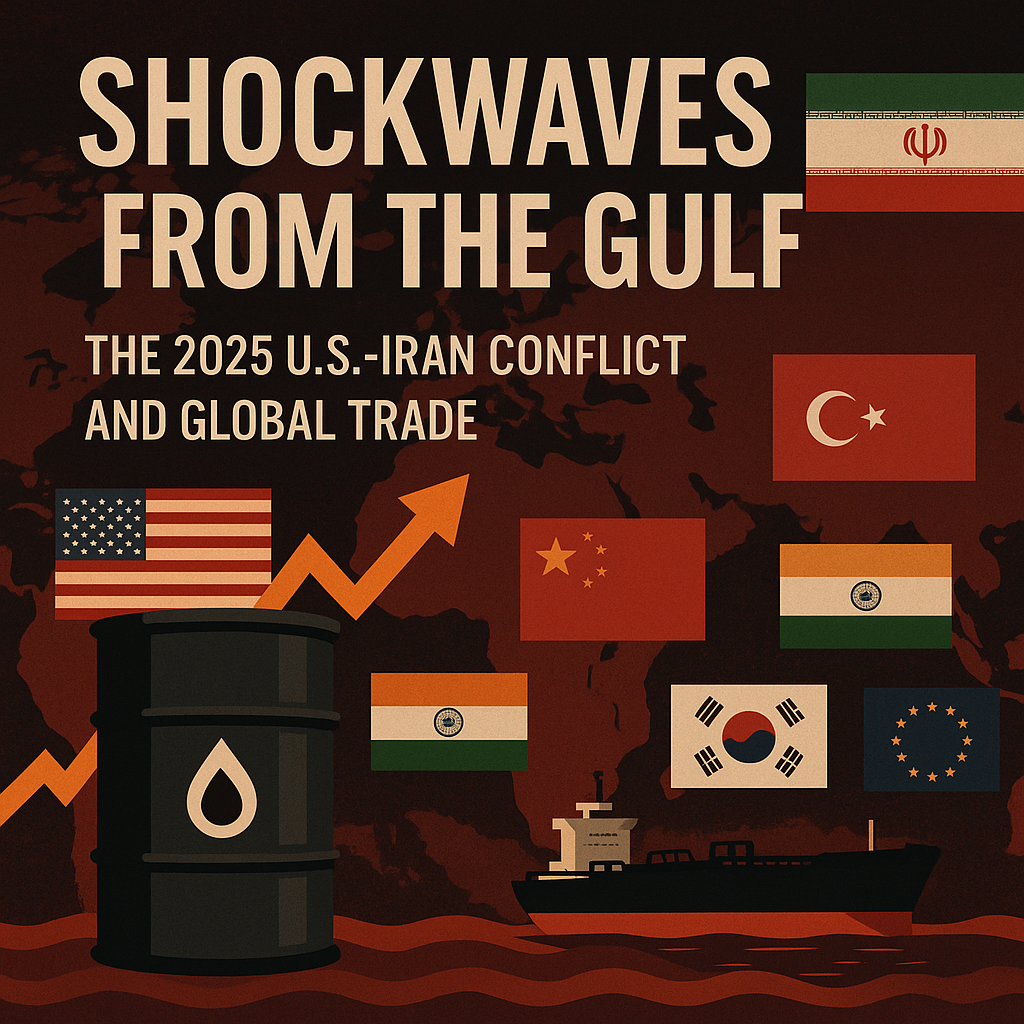Executive Summary
The June 22, 2025, U.S. airstrike targeting Iranian nuclear facilities has disrupted global energy markets, propelling Brent crude prices into the upper-$70 range per barrel. This military escalation has introduced substantial risk premiums for Persian Gulf oil exports, directly affecting nations heavily dependent on Iranian oil, notably China, India, and Turkey. The ripple effects extend indirectly to major economies like Japan, South Korea, and Europe, manifesting through heightened import costs, increased inflationary pressures, and widened trade deficits.
Flashpoint and Immediate Market Reaction
Following the U.S. strike, Brent crude surged rapidly by over 7%, pushing prices into the high-$70 per barrel range. Analysts suggest a further escalation, potentially reaching $90, should Iran take retaliatory measures such as disrupting the Strait of Hormuz, a critical chokepoint responsible for approximately 20% of global oil traffic. Even the threat of such disruption has significantly elevated shipping and insurance costs, embedding a persistent geopolitical risk premium into oil markets.
Direct Impact on Major Importers: China, India, and Turkey
China: China, the largest global importer of discounted Iranian crude—approximately 1.6 million barrels per day in 2024 is facing sharply increased input costs and mounting foreign exchange pressures. Chinese refiners, now forced to source more expensive alternatives, will likely face margin compression, potentially cascading into broader economic challenges.
India: India's reliance on Middle Eastern oil, accounting for nearly half of its daily imports totaling 4.8 million barrels, exposes it significantly to rising freight and insurance expenses. Despite proactive efforts to diversify supplies, the economic fallout from increased costs threatens growth, placing strain on already tight fiscal conditions.
Turkey: Turkey’s energy dependency, 17% of its natural gas coming directly from Iran, exacerbates vulnerabilities caused by its volatile currency and heightened economic fragility. The compounded effects of increased energy costs and currency depreciation place severe pressure on key export industries, notably automotive and textile sectors, critical to Turkey's economic stability.
Secondary Economic Pressures: Japan, South Korea, and Europe
Japan: Japan imports over 90% of its crude oil from Middle Eastern sources, prompting immediate policy interventions such as domestic gasoline price caps set at ¥175 per litre. This reflects deepening fears over potential economic disruptions and inflationary impacts on consumer spending and industrial competitiveness.
South Korea: South Korea's petrochemical sector, heavily dependent on Gulf-produced condensates, faces significant operational risk. Rising energy costs could disrupt industrial output, inflate input expenses, and negatively impact global competitiveness in manufacturing and technology sectors.
Europe: In Europe, particularly within the UK and Eurozone economies, the renewed upward pressure on energy costs threatens to reverse recent gains in combating inflation. Elevated oil prices increase production costs across a wide range of sectors, potentially stalling economic recovery and complicating monetary policy responses aimed at stabilization.
Intensifying Supply Chain and Inflationary Pressures
Post-strike disruptions have driven sharp increases in war-risk insurance premiums and shipping costs. Rates for very large crude carriers (VLCCs) on key Middle East-to-Asia routes have surged by over 20%, directly inflating consumer prices globally. Typically, each $10 increment in oil prices contributes approximately 0.3 percentage points to inflation in Asian markets and around 0.2 percentage points in European markets, amplifying costs for freight, petrochemicals, agriculture, and retail sectors worldwide.
Potential Scenarios Moving Forward
Diplomatic Cooling (45% Probability): Under this scenario, oil prices could stabilize back toward $70 per barrel if diplomatic efforts effectively mitigate tensions and the Strait of Hormuz remains operational. Nevertheless, risk premiums are expected to persist due to sustained geopolitical uncertainties.
Limited Iranian Retaliation (35% Probability): A scenario of moderate Iranian interference or harassment operations might keep oil prices near $90 per barrel through the near term. Exporters and importers would adapt accordingly, but heightened energy costs would persist, pressuring global inflation.
Extended Closure of Strait of Hormuz (20% Probability): The worst-case scenario—a prolonged blockage or significant disruption of the Strait of Hormuz—could escalate oil prices beyond $120 per barrel, substantially raising recessionary risks, particularly severe in energy-dependent economies such as Europe, India, and Japan.
Trading in the Shadow of Conflict
For traders and market participants, the 2025 U.S.-Iran conflict is a live demonstration of how quickly geopolitical tensions can reshape the global economic landscape. The oil price spike, inflation ripple effects, and shifts in freight and currency markets are not just headline events—they’re trading signals.
Energy-sensitive assets, inflation hedges, and logistics equities are back in play. FX volatility—especially in oil-importing economies like India, Turkey, and Japan—offers directional setups. Equities tied to global transport, petrochemicals, and consumer staples may see margin pressure in the quarters ahead.
This is a moment for active positioning, not passive observation. Whether you’re shorting overextended shipping stocks, rotating into energy producers, or building long volatility positions, the key is understanding that market dislocations often precede policy clarity.
Risk is back on the table. Smart capital treats it as opportunity.
